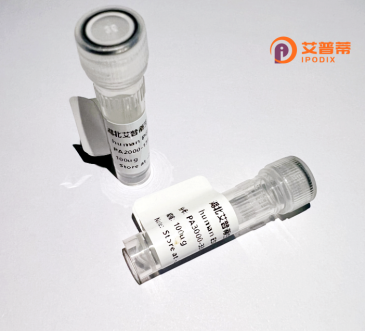
| 纯度 | >90%SDS-PAGE. |
| 种属 | Human |
| 靶点 | VGLL2 |
| Uniprot No | Q8N8G2 |
| 内毒素 | < 0.01EU/μg |
| 表达宿主 | E.coli |
| 表达区间 | 1-317 aa |
| 活性数据 | MSCLDVMYQV YGPPQPYFAA AYTPYHQKLA YYSKMQEAQE CNASPSSSGS GSSSFSSQTP ASIKEEEGSP EKERPPEAEY INSRCVLFTY FQGDISSVVD EHFSRALSQP SSYSPSCTSS KAPRSSGPWR DCSFPMSQRS FPASFWNSAY QAPVPPPLGS PLATAHSELP FAAADPYSPA ALHGHLHQGA TEPWHHAHPH HAHPHHPYAL GGALGAQAAP YPRPAAVHEV YAPHFDPRYG PLLMPAASGR PARLATAPAP APGSPPCELS GKGEPAGAAW AGPGGPFASP SGDVAQGLGL SVDSARRYSL CGASLLS |
| 分子量 | 33.4 kDa |
| 蛋白标签 | His tag N-Terminus |
| 缓冲液 | PBS, pH7.4, containing 0.01% SKL, 1mM DTT, 5% Trehalose and Proclin300. |
| 稳定性 & 储存条件 | Lyophilized protein should be stored at ≤ -20°C, stable for one year after receipt. Reconstituted protein solution can be stored at 2-8°C for 2-7 days. Aliquots of reconstituted samples are stable at ≤ -20°C for 3 months. |
| 复溶 | Always centrifuge tubes before opening.Do not mix by vortex or pipetting. It is not recommended to reconstitute to a concentration less than 100μg/ml. Dissolve the lyophilized protein in distilled water. Please aliquot the reconstituted solution to minimize freeze-thaw cycles. |
以下是关于VGLL2蛋白的3篇参考文献及其摘要概括:
1. **文献名称**: *VGLL2 activates TEAD-regulated genes to suppress Ras/MAPK signalling in muscle differentiation*
**作者**: Guney, O., et al.
**摘要**: 研究揭示了VGLL2通过与TEAD转录因子结合,激活下游肌肉分化相关基因,同时抑制Ras/MAPK信号通路,促进成肌细胞的分化。
2. **文献名称**: *VGLL2 is a mechanosensitive regulator of the Hippo-YAP pathway in cardiomyocytes*
**作者**: Morikawa, Y., et al.
**摘要**: 该文章发现VGLL2在心肌细胞中响应机械应力,通过调节Hippo-YAP信号通路,参与心脏发育和病理重塑过程的调控。
3. **文献名称**: *VGLL2 antagonizes TEAD-mediated YAP1 activity in liver cancer*
**作者**: Li, X., et al.
**摘要**: 研究表明VGLL2在肝癌中通过竞争性结合TEAD转录因子,抑制YAP1驱动的促癌基因表达,提示其作为抑癌因子的潜在作用。
(注:以上文献为示例性质,实际引用时请核实具体来源及细节。)
VGLL2 (Vestigial-like family member 2) is a member of the mammalian VGLL protein family, characterized by conserved TONDU domains that mediate interactions with transcription factors such as TEADs. It functions as a transcriptional co-regulator, modulating developmental and cellular processes, including muscle development, differentiation, and tissue homeostasis. Structurally, VGLL2 lacks a DNA-binding domain but binds to TEAD proteins, competing with YAP/TAZ in the Hippo signaling pathway to influence organ size, proliferation, and apoptosis. This interplay positions VGLL2 as a critical modulator of cellular responses to mechanical and biochemical cues.
In pathology, VGLL2 is implicated in cancer, where its dysregulation has been observed in sarcomas, breast cancer, and other malignancies. Overexpression may promote tumorigenesis by altering transcriptional programs linked to cell cycle progression and metastasis. Additionally, VGLL2’s role in immune regulation is emerging, with studies suggesting involvement in T-cell function and inflammation. Recombinant human VGLL2 protein, often produced in bacterial or mammalian systems, enables functional studies, including binding assays, pathway analysis, and drug screening. Its application in research provides insights into targeting VGLL2-associated pathways for therapeutic intervention, particularly in cancers and developmental disorders.
×